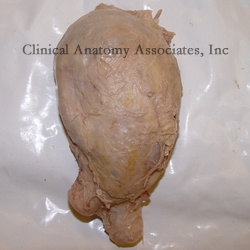|
UPDATED: This word has a Greek origin from the term [ανεύρυσμα], composed of [ana] meaning "complete or throughout", and [eurus] meaning "wide", a "complete widening or dilation". It is used to refer to the dilation of an artery. Aneurysms can be formed in any artery, although they have some preferred sites. The most common aneurysms are found in the aorta, arterial circle of Willis, the root of the cerebral arteries, and internal carotid arteries. Biomechanical studies suggest that once an aneurysm forms it will generally progress in its dilation until aneurysmal rupture. Because of turbulent flow within the aneurysm large clots are usually formed, which in turn can cause emboli. The image shows an excised infrarenal abdominal aortic aneurysm (AAA). The two common iliac arteries can be seen. If you click on the image you will be able to see the same aneurysm opened through its posterior wall and the clot that was contained inside. Since the definition of [aneurysm] is "a dilation of an artery", it is wrong to refer to the dilation of a vein as a "venous aneurysm. The proper term to refer to the dilation of a vein is [varix]. Image property of: CAA.Inc. Photographer: David M. Klein |
|
| MTD Main Page | Subscribe to MTD |
